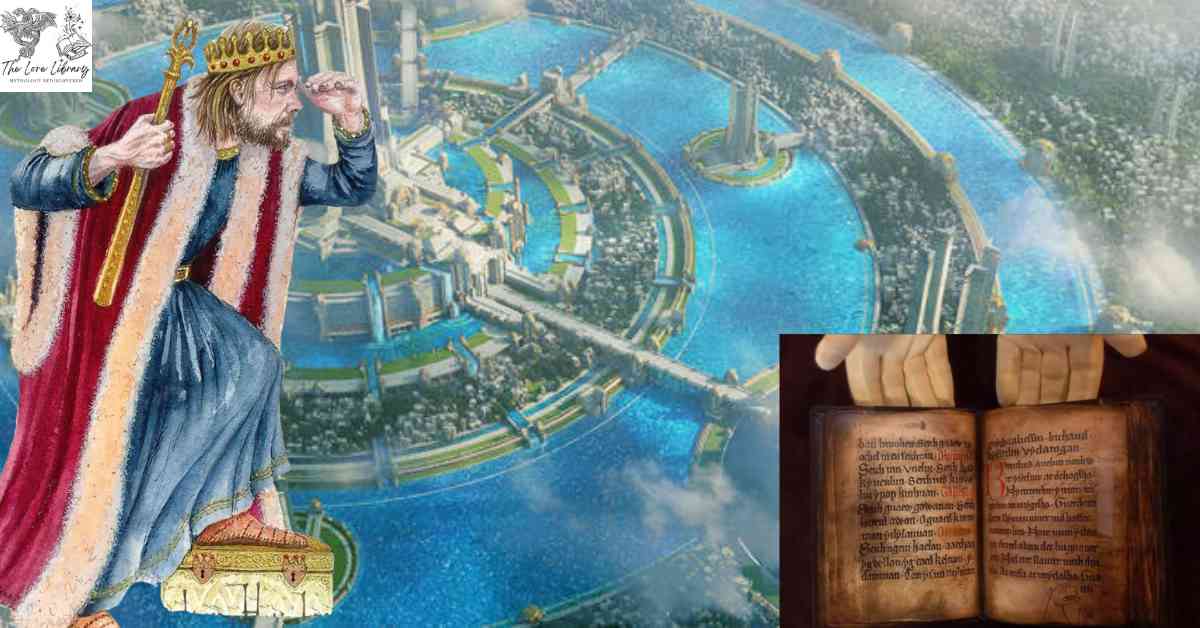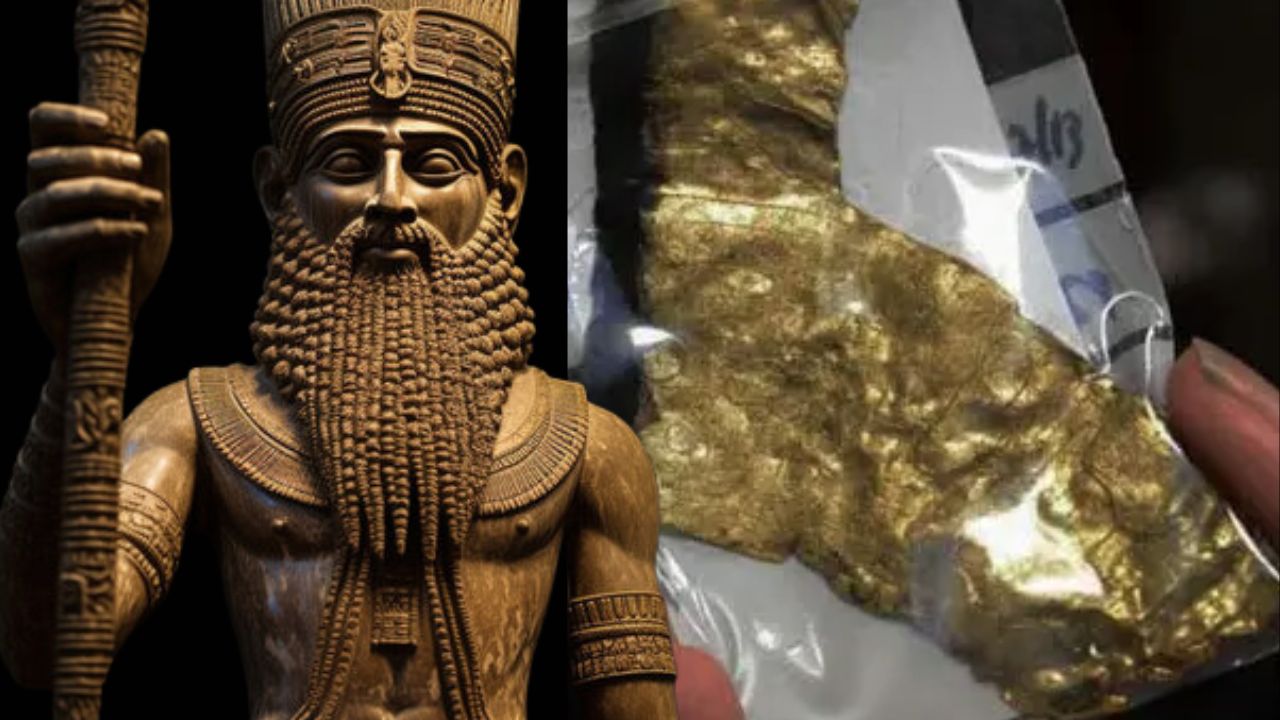In the depths of the Atlantic Ocean, the ancient philosopher Plato described the enigmatic lost city of Atlantis. Yet, not far from where Plato may have surmised its location, another legendary land submerged by the sea captures our imagination. Its lore is not only just as fascinating as Atlantis’s, but recent discoveries have also surfaced, suggesting this place may have indeed been real. Yes, We are talking about the Welsh Atlantis aka Kingdom of Cantre’r Gwaelod.
Cantre’r Gwaelod: The Welsh Atlantis
In the historic county of Ceredigion, nestled along the coast of Wales, there exists a tapestry of legends woven from the Middle Ages. These tales speak of an enigmatic ancient forest, long since vanished, that cradled a kingdom between its boughs.
This lush woodland spanned across fertile grounds, stretching approximately 20 miles beyond the current shoreline, encapsulating the space between Ramsey Island and Bardsey Island within the now waters of Cardigan Bay. The villages of Borth and Ynyslas lie in proximity to this fabled land, their names whispered alongside these storied echoes of the past.
Experience the rich history of Wales with the Ceredigion legends, and embark on a journey back to the time of an awe-inspiring forest kingdom, concealed beneath the waves of Cardigan Bay.
A myth mentioned in the Black Book of Carmarthen—the oldest surviving complete manuscript written in Welsh—dating back to at least the 13th century, tells how the forest was part of an ancient kingdom known as Cantre’r Gwaelod, or the ‘Hundred Lowlands’. This 4,500- to 5,000-year-old kingdom was reportedly ruled by a wealthy king named Gwyddno Garanhir, who presided over at least 16 cities filled with vibrant marketplaces that served as trading hubs.
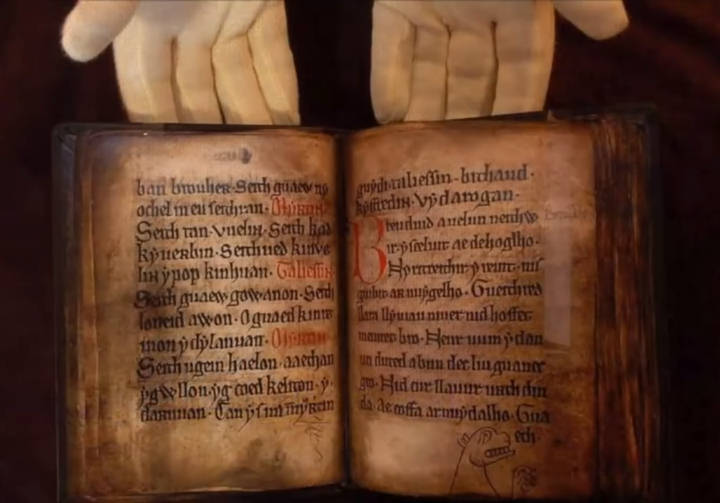
The Legend of Cantre’r Gwaelod’s Tragic End
The nostalgic legend of Cantre’r Gwaelod is one of grandeur and tragedy. Meticulously preserved in the pages of the Black Book of Carmarthen, which stands as the oldest surviving manuscript penned in the Welsh language, this tale transports us back to a time shrouded in history and mythology. Dating to at least the 13th century, the manuscript reveals details of a once prosperous realm, known in Welsh as Cantre’r Gwaelod, or ‘The Hundred Lowlands.’
This kingdom, flourishing between 4,500 and 5,000 years ago, was said to be under the rule of the affluent King Gwyddno Garanhir. His domain was reported to encompass over 16 flourishing cities. Marketplaces abuzz with activity punctuated these cities, marking them as significant trading posts of their time.
The Tale of Cantre’r Gwaelod’s Demise
The lore surrounding Cantre’r Gwaelod speaks not only of its splendor but also its ultimate downfall. Embark on a journey through time as we delve into this Welsh myth, chronicled meticulously in the Black Book of Carmarthen—the earliest complete Welsh manuscript in existence. Dating back at least to the 13th century, it offers a window into an ancient world of marvelous achievements.
Envision a kingdom that emerged over four millennia ago, presided over by the illustrious King Gwyddno Garanhir. His prosperous rule extended across a network of 16 bustling urban centers, each a beacon of commerce with markets teeming with merchants and goods. These cities served as crucial trading centers, fueling the economy and culture of Cantre’r Gwaelod.
Legends Tell of a Lost Kingdom Drowned by Negligence: The Cautionary Tale of Seithenyn and Mererid
Ancient myths often hold fragments of history, warning future generations through their mournful tales. One such tale speaks of a once-prosperous land, protected from the fierce sea by a mighty dike. The safety of this kingdom hinged on the vigilance of its guardians. Tragically, the kingdom met its watery demise due to a fatal moment of inattention—an error that sent an entire forest and kingdom to the depths, a stark reminder of responsibility.
The Negligence of Prince Seithenyn
According to legend, two princes were entrusted with the critical task of guarding the dike. One prince, Seithenyn, is famously known for his disastrous fall from duty. The stories recount how Seithenyn, consumed by alcohol, let his guard down. His intoxication precluded him from managing the floodgates, which stood as the bulwark against the relentless sea. As Seithenyn reveled, the unguarded gates allowed the ocean to surge forward, claiming the land and condemning the kingdom to an aquatic grave.
The Distraction of Mererid
In another rendition of the legend, a maiden named Mererid stands at the story’s heart. Mererid’s role was crucial—she was the keeper of the floodgates. However, tales weave a narrative of love and distraction as she fell into a romantic entanglement with Seithenyn. It was this fateful romance that led to the dire outcome, as Mererid’s attention shifted from her duty to her heart’s desire just when the floodgates needed to be sealed. The result was as catastrophic as the tale involving Seithenyn’s negligence—the relentless waters broke through, engulfing the kingdom.
The Moral of the Myth
Both versions of the story are poignant in their endings, serving as eternal reminders of the importance of responsibility and the consequences of neglect. The legend cautions us to remain vigilant in our charges, for the cost of neglect can be irreversibly devastating. Whether through careless revelry or the distractions of the heart, the outcome remains the same—a civilization lost beneath the waves, remembered only in myth and legend.
The tale of Seithenyn and Mererid may be woven from the threads of bygone eras, but its message is timeless. As we continue to build and protect our own “kingdoms,” both literal and metaphorical, we must stay mindful of our duties. Otherwise, we may find ourselves echoing the regrets of legends long gone.
While these stories have remained part of the collective imagination of Wales for millennia, they were brought back to life thanks to a violent storm that occurred just a few years ago.
The Legendary Forest Emerges
In late April 2019, Storm Hannah hit Britain with wind gusts reaching more than 80 mph, causing power outages and travel disruptions across Wales. As the storm hit the coasts of Borth and Ynyslas, the remains of peat-covered trees that had been buried under saltwater and sand for thousands of years resurfaced. Some related these ancient stumps to the forest of the mythical Cantre’r Gwaelod.
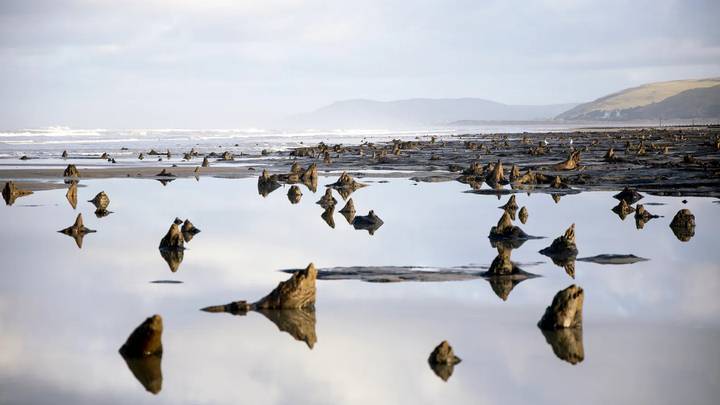
Credit: Chris Griffiths.
Petrified stumps like these have been popping up here and there in the area for several years, particularly in 2010 and 2014 when previous storms ripped pebbles and sand from the shoreline. However, Hannah caused a much larger stretch of the forest to be revealed, and every day since then, at low tide, the sea reveals hundreds of eerie-looking stumps that look like jagged jaws along the black sand beach of two miles long.
Scientific Discoveries Linked to the Mythical Forest
Scientists have discovered that the submerged forest contains stumps of pine, alder, oak, and birch, which have been preserved due to the lack of oxygen and high alkaline levels found in the swamp. The living trees were gradually inundated with peat when the area was submerged by rising sea levels about 4,000-5,000 years ago. As the level rose and a thick layer of peat formed from natural sedimentation, the trees stopped growing and eventually died.
Old animal bones and a pair of deer antlers have also been discovered here, suggesting that this tract of land once flourished when sea levels were lower and before the area had completely succumbed to the ocean.
The Welsh Atlantis or Atlantis of Wales
Whether or not the forest is the one mentioned in the Cantre’r Gwaelod myth, archaeologists believe there was life here dating back to at least the Bronze Age (3000 to 1200 BC), in part due to the discovery of a wooden walkway made from cut branches and vertical posts (designed to cope with rising water levels) believed to be between 3,100 and 4,000 years old.
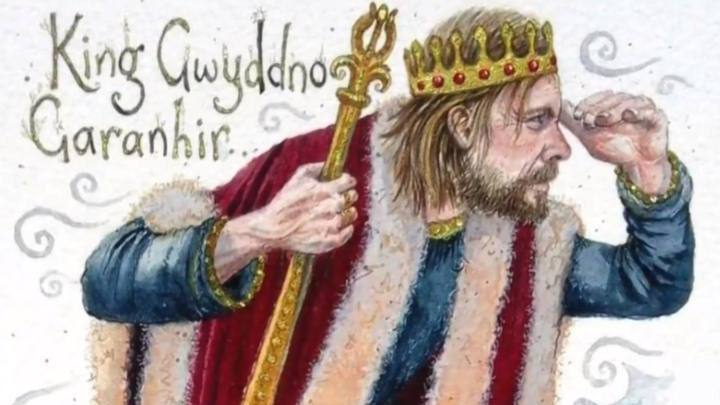
Several other archaeological discoveries have been made here, including fossilized human and animal footprints preserved in the hardened top layer of peat, along with scattered burnt stones thought to have come from ancient hearths. Because of this evidence of human settlement, the media often refers to the area as “the Atlantis of Wales.”
Climate Change Revealing Ancient Artifacts and Welsh Atlantis
Archaeologists believe that extreme weather due to climate change is exposing older artifacts such as those from Borth and Ynyslas.
As reported in Wales Online, Alun Hubbard, professor in the Department of geography and Earth Sciences at Aberystwyth University, suggests that the discovery of the stumps could also be partly due to sea defenses installed at Borth in 2012. While they have protected the town from breaking waves, they have also changed the continuous movement of sand, pebbles, and stones that previously hid the stumps from view.
Other submerged forests unearthed by recent storms appeared on Newgale Beach in Pembrokeshire and Mount Bay in Cornwall, both in 2014. In that same year, 850,000-year-old footprints considered the earliest evidence of humans outside Africa were revealed by storms in Norfolk, England. An ichthyosaur fossil was also unearthed, and total destruction of the site was narrowly avoided – after a storm collapsed cliffs and rocks along the Jurassic Coast of Dorset and East Devon in southern England.
Keeping the Legend Alive
However, the discovery of the hundreds of tree stumps petrified by Storm Hannah has become perhaps the most talked about revelation locally, as historians and archaeologists now have more reason to think the forest may be related to the myth of the Hundred Lowlands, as mentioned in The Black Book of Carmarthen.
The aforementioned medieval manuscript is currently housed in the National Library of Wales in Aberystwyth, while a facsimile copy can be viewed online here. Along with the famous Welsh folk song, The Bells of Aberdovey – which is also believed to allude to the story of Cantre’r Gwaelod – the references mentioned in the book have helped keep the legend alive – in fact, locals insist that on a calm day, they can still hear the bells of a submerged church from the ancient kingdom.
Similarly, one of the stories in The Mabinogion – a book of Welsh stories collected from oral traditions of the 11th century and earlier – refers to the “drowning” of the kingdom that once stood between Wales and Ireland which maybe the Welsh atlantis.
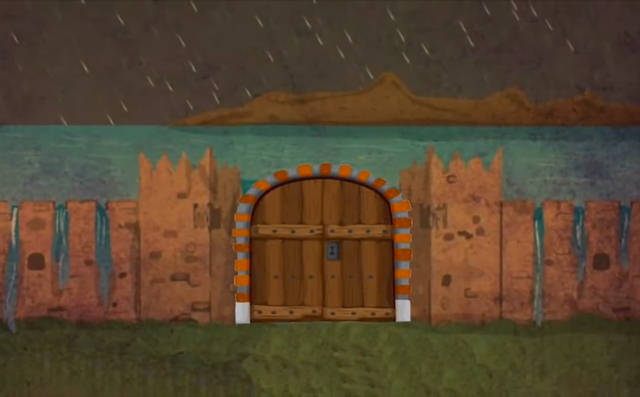
And while there are no historical records documenting that an entire kingdom was wiped out, scientists think this land was lost to the sea when the oceans gradually rose to their current levels, beginning about 8,000 years ago, after the ice sheet of the most recent Ice Age will decrease. Pebble clays and gravelly sands deposited by melting ice sheets began to form pebble beaches and ridges, which moved over forested areas along the coast.
In this way, the petrified trees discovered at Borth and Ynslas point to some truths in the legend, showing evidence of a previous life that existed under the sea. But perhaps most importantly, they are also connecting a new generation to the stories of their ancestors.
References:
- How a storm revealed a Welsh kingdom – BBC.
- The lost land of Cantre’r Gwaelod: The Welsh Atlantis? – Herald Wales.
- The Welsh ATLANTIS: Is There Another LOST Kingdom Under the Sea? – Ancient Architects.
Shop amazing Anunnaki Merchandise at our store, Follow us on Facebook, Instagram, And For More Interesting Content Also Subscribe To Our Youtube Channel.




